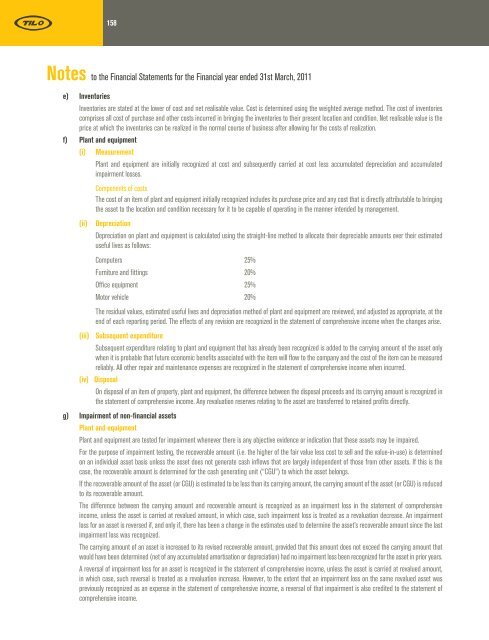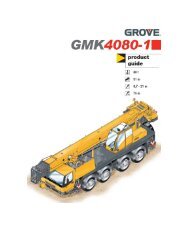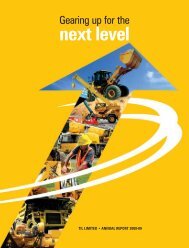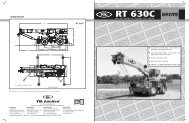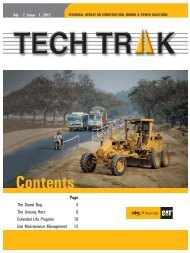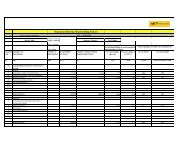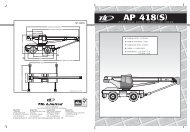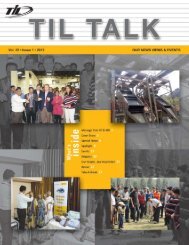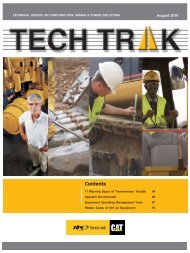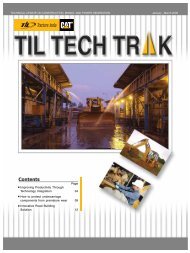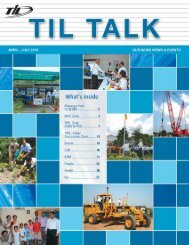view / download the documents. - til india
view / download the documents. - til india
view / download the documents. - til india
Create successful ePaper yourself
Turn your PDF publications into a flip-book with our unique Google optimized e-Paper software.
158Notes to <strong>the</strong> Financial Statements for <strong>the</strong> Financial year ended 31st March, 2011e) InventoriesInventories are stated at <strong>the</strong> lower of cost and net realisable value. Cost is determined using <strong>the</strong> weighted average method. The cost of inventoriescomprises all cost of purchase and o<strong>the</strong>r costs incurred in bringing <strong>the</strong> inventories to <strong>the</strong>ir present location and condition. Net realisable value is <strong>the</strong>price at which <strong>the</strong> inventories can be realized in <strong>the</strong> normal course of business after allowing for <strong>the</strong> costs of realization.f) Plant and equipment(i) MeasurementPlant and equipment are initially recognized at cost and subsequently carried at cost less accumulated depreciation and accumulatedimpairment losses.Components of costsThe cost of an item of plant and equipment initially recognized includes its purchase price and any cost that is directly attributable to bringing<strong>the</strong> asset to <strong>the</strong> location and condition necessary for it to be capable of operating in <strong>the</strong> manner intended by management.(ii)DepreciationDepreciation on plant and equipment is calculated using <strong>the</strong> straight-line method to allocate <strong>the</strong>ir depreciable amounts over <strong>the</strong>ir estimateduseful lives as follows:Computers 25%Furniture and fittings 20%Office equipment 25%Motor vehicle 20%The residual values, estimated useful lives and depreciation method of plant and equipment are re<strong>view</strong>ed, and adjusted as appropriate, at <strong>the</strong>end of each reporting period. The effects of any revision are recognized in <strong>the</strong> statement of comprehensive income when <strong>the</strong> changes arise.(iii) Subsequent expenditureSubsequent expenditure relating to plant and equipment that has already been recognized is added to <strong>the</strong> carrying amount of <strong>the</strong> asset onlywhen it is probable that future economic benefits associated with <strong>the</strong> item will flow to <strong>the</strong> company and <strong>the</strong> cost of <strong>the</strong> item can be measuredreliably. All o<strong>the</strong>r repair and maintenance expenses are recognized in <strong>the</strong> statement of comprehensive income when incurred.(iv) DisposalOn disposal of an item of property, plant and equipment, <strong>the</strong> difference between <strong>the</strong> disposal proceeds and its carrying amount is recognized in<strong>the</strong> statement of comprehensive income. Any revaluation reserves relating to <strong>the</strong> asset are transferred to retained profits directly.g) Impairment of non-financial assetsPlant and equipmentPlant and equipment are tested for impairment whenever <strong>the</strong>re is any objective evidence or indication that <strong>the</strong>se assets may be impaired.For <strong>the</strong> purpose of impairment testing, <strong>the</strong> recoverable amount (i.e. <strong>the</strong> higher of <strong>the</strong> fair value less cost to sell and <strong>the</strong> value-in-use) is determinedon an individual asset basis unless <strong>the</strong> asset does not generate cash inflows that are largely independent of those from o<strong>the</strong>r assets. If this is <strong>the</strong>case, <strong>the</strong> recoverable amount is determined for <strong>the</strong> cash generating unit (“CGU”) to which <strong>the</strong> asset belongs.If <strong>the</strong> recoverable amount of <strong>the</strong> asset (or CGU) is estimated to be less than its carrying amount, <strong>the</strong> carrying amount of <strong>the</strong> asset (or CGU) is reducedto its recoverable amount.The difference between <strong>the</strong> carrying amount and recoverable amount is recognized as an impairment loss in <strong>the</strong> statement of comprehensiveincome, unless <strong>the</strong> asset is carried at revalued amount, in which case, such impairment loss is treated as a revaluation decrease. An impairmentloss for an asset is reversed if, and only if, <strong>the</strong>re has been a change in <strong>the</strong> estimates used to determine <strong>the</strong> asset’s recoverable amount since <strong>the</strong> lastimpairment loss was recognized.The carrying amount of an asset is increased to its revised recoverable amount, provided that this amount does not exceed <strong>the</strong> carrying amount thatwould have been determined (net of any accumulated amortisation or depreciation) had no impairment loss been recognized for <strong>the</strong> asset in prior years.A reversal of impairment loss for an asset is recognized in <strong>the</strong> statement of comprehensive income, unless <strong>the</strong> asset is carried at revalued amount,in which case, such reversal is treated as a revaluation increase. However, to <strong>the</strong> extent that an impairment loss on <strong>the</strong> same revalued asset waspreviously recognized as an expense in <strong>the</strong> statement of comprehensive income, a reversal of that impairment is also credited to <strong>the</strong> statement ofcomprehensive income.


